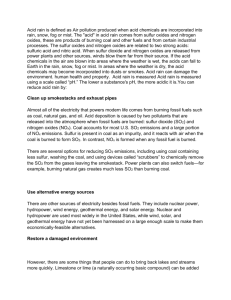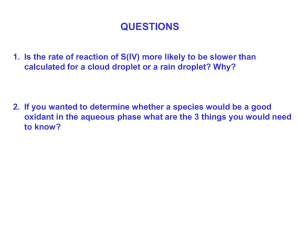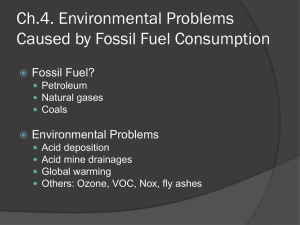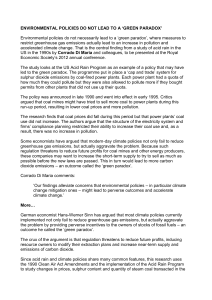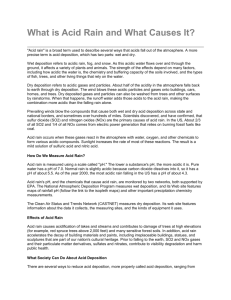What is Acid Rain?
advertisement
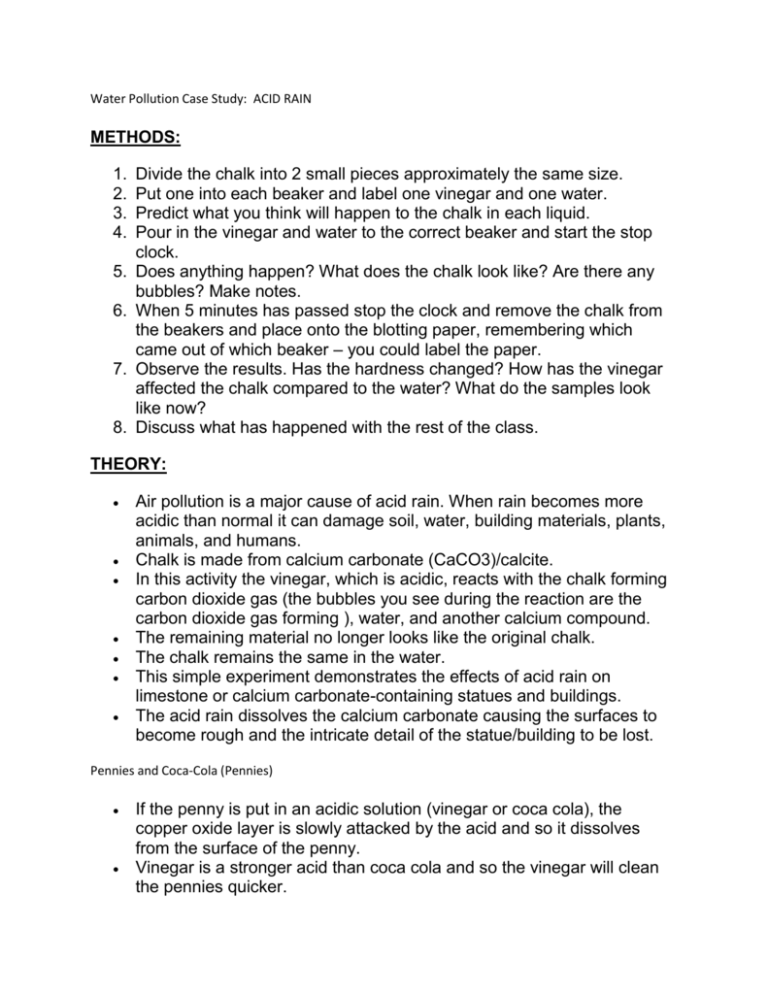
Water Pollution Case Study: ACID RAIN METHODS: 1. 2. 3. 4. 5. 6. 7. 8. Divide the chalk into 2 small pieces approximately the same size. Put one into each beaker and label one vinegar and one water. Predict what you think will happen to the chalk in each liquid. Pour in the vinegar and water to the correct beaker and start the stop clock. Does anything happen? What does the chalk look like? Are there any bubbles? Make notes. When 5 minutes has passed stop the clock and remove the chalk from the beakers and place onto the blotting paper, remembering which came out of which beaker – you could label the paper. Observe the results. Has the hardness changed? How has the vinegar affected the chalk compared to the water? What do the samples look like now? Discuss what has happened with the rest of the class. THEORY: Air pollution is a major cause of acid rain. When rain becomes more acidic than normal it can damage soil, water, building materials, plants, animals, and humans. Chalk is made from calcium carbonate (CaCO3)/calcite. In this activity the vinegar, which is acidic, reacts with the chalk forming carbon dioxide gas (the bubbles you see during the reaction are the carbon dioxide gas forming ), water, and another calcium compound. The remaining material no longer looks like the original chalk. The chalk remains the same in the water. This simple experiment demonstrates the effects of acid rain on limestone or calcium carbonate-containing statues and buildings. The acid rain dissolves the calcium carbonate causing the surfaces to become rough and the intricate detail of the statue/building to be lost. Pennies and Coca-Cola (Pennies) If the penny is put in an acidic solution (vinegar or coca cola), the copper oxide layer is slowly attacked by the acid and so it dissolves from the surface of the penny. Vinegar is a stronger acid than coca cola and so the vinegar will clean the pennies quicker. The reaction with acid is this: CuO (s) +2H3O+ (aq) +3H2O (l) ->[Cu(H2O)6]2+ (aq) This is compared to placing a penny into an alkaline (most household cleaners are alkaline) or neutral solution (water). Alkaline is the opposite of acidic, and neutral means that it is neither acidic nor alkaline, it is in the middle. The copper oxide on the pennies is not removed by either of these types of solution. You can see how well the pennies are cleaned by coca cola. This is why it is important to avoid drinking too much fizzy drink such as coca cola or to make sure you brush your teeth regularly. The acidic properties of the drink can damage the protective layer on the outside of teeth, causing them to become more sensitive. Secondly the sugar can also cause tooth decay. What is Acid Rain? "Acid rain" is a broad term referring to a mixture of wet and dry deposition (deposited material) from the atmosphere containing higher than normal amounts of nitric and sulfuric acids. The precursors, or chemical forerunners, of acid rain formation result from both natural sources, such as volcanoes and decaying vegetation, and man-made sources, primarily emissions of sulfur dioxide (SO2)and nitrogen oxides (NOx) resulting from fossil fuel combustion. In the United States, roughly 2/3 of all SO2 and 1/4 of all NOx come from electric power generation that relies on burning fossil fuels, like coal. Acid rain occurs when these gases react in the atmosphere with water, oxygen, and other chemicals to form various acidic compounds. The result is a mild solution of sulfuric acid and nitric acid. When sulfur dioxide and nitrogen oxides are released from power plants and other sources, prevailing winds blow these compounds across state and national borders, sometimes over hundreds of miles. Measuring Acid Rain Acid rain is measured using a scale called “pH.” The lower a substance's pH, the more acidic it is. Pure water has a pH of 7.0. However, normal rain is slightly acidic because carbon dioxide (CO2) dissolves into it forming weak carbonic acid, giving the resulting mixture a pH of approximately 5.6 at typical atmospheric concentrations of CO2. As of 20014, the most acidic rain falling in the U.S. has a pH of about 4.3. Effects of Acid Rain Acid rain causes acidification of lakes and streams and contributes to the damage of trees at high elevations (for example, red spruce trees above 2,000 feet) and many sensitive forest soils. In addition, acid rain accelerates the decay of building materials and paints, including irreplaceable buildings, statues, and sculptures that are part of our nation's cultural heritage. Prior to falling to the earth, sulfur dioxide (SO2) and nitrogen oxide (NOx) gases and their particulate matter derivatives— sulfates and nitrates—contribute to visibility degradation and harm public health. What can we do? Clean up smokestacks and exhaust pipes Almost all of the electricity that powers modern life comes from burning fossil fuels such as coal, natural gas, and oil. Acid deposition is caused by two pollutants that are released into the atmosphere when fossil fuels are burned: sulfur dioxide (SO2) and nitrogen oxides (NOx). Coal accounts for most U.S. SO2 emissions and a large portion of NOx emissions. Sulfur is present in coal as an impurity, and it reacts with air when the coal is burned to form SO2. In contrast, NOx is formed when any fossil fuel is burned. There are several options for reducing SO2 emissions, including using coal containing less sulfur, washing the coal, and using devices called “scrubbers” to chemically remove the SO2 from the gases leaving the smokestack. Power plants can also switch fuels—for example, burning natural gas creates much less SO2 than burning coal. Certain approaches will also have the additional benefit of reducing other pollutants such as mercury and carbon dioxide (CO2). Understanding these “co-benefits” has become important in seeking cost-effective air pollution reduction strategies. Finally, power plants can use technologies that do not burn fossil fuels. Each of these options, however, has its own costs and benefits; there is no single universal solution. Similar to scrubbers on power plants, catalytic converters reduce NOx emissions from cars. These devices have been required for over 20 years in the United States, and it is important to keep them working properly. Recently, tailpipe restrictions were tightened to help curb NO x emissions. EPA also continues to make, changes to gasoline that allow it to burn cleaner. Use alternative energy sources There are other sources of electricity besides fossil fuels. They include nuclear power, hydropower, wind energy, geothermal energy, and solar energy. Nuclear and hydropower are used most widely in the United States, while wind, solar, and geothermal energy have not yet been harnessed on a large enough scale to make them economically-feasible alternatives. There are also alternative energies, such as natural gas, batteries, and fuel cells, available to power automobiles. All sources of energy have environmental costs as well as benefits. Some types of energy are more expensive to produce than others, which means that not all Americans can afford all of them. Nuclear power, hydropower, and coal are the cheapest formsof energy today, but advancements in technologies and regulatory developments may change this in the future. All of these factors must be weighed when deciding which energy source to use today and which to invest in for tomorrow. Restore a damaged environment Acid deposition penetrates deeply into the fabric of an ecosystem, changing the chemistry of the soil and streams and narrowing—sometimes to nothing—the space where certain plants and animals can survive. Because there are so many changes, it takes many years for ecosystems to recover from acid deposition, even after emissions are reduced and the rain pH is restored to normal. For example, while visibility might improve within days, and small or episodic chemical changes in streams improve within months, chronically acidified lakes, streams, forests, and soils can take years to decades, or even centuries (in the case of soils) to heal. However, there are some things that people can do to bring back lakes and streams more quickly. Limestone or lime (a naturally occurring basic compound) can be added to acidic lakes to “cancel out” the acidity. This process, called liming, has been used extensively in Norway and Sweden but is not used very often in the United States Liming tends to be expensive, has to be done repeatedly to keep the water from returning to its acidic condition, and is considered a short-term remedy in only specific areas, rather than an effort to reduce or prevent pollution. Furthermore, it does not solve the broader problems of changes in soil chemistry and forest health in the watershed, and it does nothing to address visibility reductions, materials damage, and risk to human health. However, liming does often permit fish to remain in a lake, allowing the native population to survive in place until emissions reductions reduce the amount of acid deposition in the area. CASE STUDY: ACID RAIN Chalk Demo: OBSERVATIONS: INFERENCES: Pennies/Coca-Cola Demo: OBSERVATIONS: INFERENCES: What is ACID RAIN? How is it MEASURED? What are the EFFECTS? What are 3 MITIGATION techniques?
